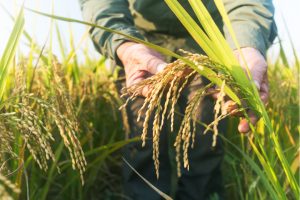Carbon capture and storage is one of the strategies being considered to achieve carbon neutrality or “net zero” by the middle of this century, meaning no increase in greenhouse gases responsible for climate change in the atmosphere. In other words, offsetting emissions by removing CO2 from the atmosphere. Proposals for new carbon capture technologies are the subject of intense debate about their feasibility. But there is another avenue being explored by a great deal of research: food production, which takes up almost half of the planet’s habitable land. Plants, including the ones we grow to feed ourselves, sequester carbon, so why not use science to make our crops harvest even more carbon?

Plants live thanks to a wonderful natural system that absorbs CO2 from the atmosphere: photosynthesis. This process returns clean oxygen to the atmosphere and incorporates carbon into the soil and vegetable material, allowing plants to grow. Contrary to a widespread myth about the so-called “lungs of the planet”, we do not actually depend on photosynthesis by photosynthetic organisms to keep us breathing, as the vast majority of oxygen in the atmosphere is a legacy from Earth’s early history, and the net balance between the oxygen produced by photosynthesis and that consumed by ecosystems themselves is virtually zero.
But through photosynthesis, plants and soils accumulate immense amounts of carbon, the release of which into the atmosphere would be catastrophic for climate change. If we could somehow increase the amount of carbon sequestered by our vast fields of crops, we would have a good ally in plants. Scientists are now exploring a variety of methods to achieve this goal.
Chemical weathering
At the University of Sheffield, a team led by David Beerling is working on one of the main lines of this research: increasing carbon sequestration not in plants themselves, but in agricultural soils by encouraging a phenomenon known as chemical weathering, which consists of the reaction of minerals with water, gases and chemical compounds from the great terrestrial machine. This is one of the processes that, over geological time, break down rocks and change the landscape, circulating oxygen between two types of rock—carbonates and silicates—in a cycle that controls the amount of CO2 present in the atmosphere and therefore regulates Earth’s climate.

During this process, rain washes away CO2, which reacts with minerals to form bicarbonates, which are deposited on the ground or carried by currents to the sea. A technique known as enhanced rock weathering attempts to force the cycle towards increased carbonate production to remove more CO2 from the atmosphere. Under natural conditions, the chemical weathering of rocks absorbs 1.1 billion tonnes of CO2 per year.
Beerling’s proposal is based on spraying crushed basalt rock dust on agricultural soils to increase the surface area available for weathering. If applied worldwide, it could sequester up to two billion tonnes of CO2 per year by 2050. The idea is to use discarded rock from mining, waste concrete and foundry slag, and the calculation by the researcher and his collaborators includes the cost in emissions of the other processes involved, such as the energy needed to implement it. According to study co-author Steven Banwart, “the practice of spreading crushed rock to improve soil pH is commonplace in many agricultural regions worldwide. The technology and infrastructure already exist to adapt these practices to utilise basalt rock dust.”
Genetic editing of plants
Another option is to boost the ability of plants themselves to absorb CO2. At the Salk Institute of Biology in San Diego, Wolfgang Busch’s group leads the Harnessing Plants Initiative, an international collaboration to find the genes that increase carbon sequestration in plants. Busch and his collaborators previously identified a gene that helps roots grow deeper, allowing them to store more carbon for longer.

In addition to increasing the depth of the roots, the researchers want to increase their mass and the amount of suberin, a polymer (the most familiar form of which is cork) that has a high carbon storage capacity. Once the perfect combination of genes has been found using gene-editing systems, the scientists will produce the seeds using conventional breeding techniques to avoid the restrictions associated with genetically modified crops. They hope to produce more CO2-hungry varieties of corn, rice, wheat, soybean, canola and sorghum.
A different approach aims to turbo-charge photosynthesis, a process that is curiously rather inefficient in nature. At the Innovative Genomics Institute, founded by CRISPR gene-editing pioneer Jennifer Doudna, researchers are trying to tweak the genes of rice and sorghum to improve photosynthesis, a project they estimate could increase the carbon sequestration of crops by one billion tonnes of CO2 per year.

Not all proposed solutions to improve the carbon sequestration capacity of crops come from the laboratory. Other initiatives are based on improving farm management, for example by choosing crops with higher storage capacity and using compost instead of chemical fertilisers. The ideas are many and varied, adding momentum to the idea of carbon farming as a growing field of research that can make a major contribution to the collective effort to combat climate change.
Comments on this publication